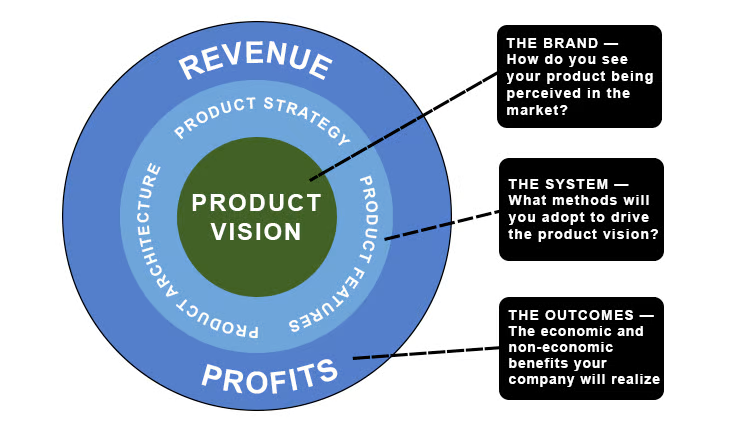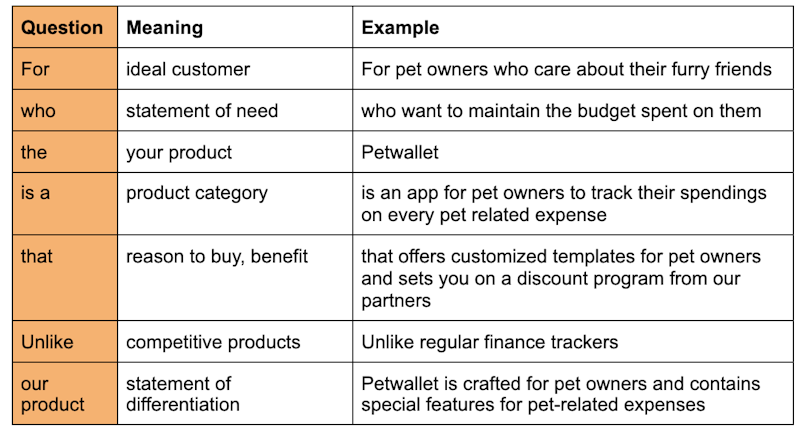Every great idea starts with a product vision statement. Well, in the world of product development anyway. Developing a product is a lengthy process and, unless you wear many hats, a collaborative one at that. With so many chefs in the kitchen, the original vision for a product can easily get lost in the sauce. That’s where your vision statement comes in.
From selecting the best features to creating a marketing campaign, your vision statement will steer you in the right direction. As a result, your business will enjoy a more efficient development process and a better overall product that is perfectly aligned with your corporate goals.
This article answers all your burning questions about developing a product vision statement that will propel your product to new heights of excellence. Let’s dig in.
What is a product vision statement?
A product vision statement outlines a company’s long-term mission, vision, and other key attributes.
At its core, a product vision statement is aspirational, painting a picture of how the product will evolve. It drills down to the important questions; why you’re building a product and what you hope to achieve with it in the future.

A word of caution, though. An aspirational product vision isn’t enough on its own. It should also be actionable, aligned to corporate goals, and accessible to everyone involved.
From the product team to the marketing team, the product vision statement acts as a single point of reference for everyone in the business. What’s more, it serves as an active reminder of the common goal the business is trying to achieve with the product.
The product vision statement usually includes a mission (what we want to do) and a vision (how the world will look when we succeed in our mission). These act as blueprints going forward.
Recap: A product vision statement describes the future of a product. It captures the essence of what the product is, why it was created, and where it’s going. As such, it serves as the North Star for stakeholders and team members, reminding them of the shared objectives, vision, and direction the product should be moving in.
Why a product vision statement is necessary
If the product vision statement is the North Star, developing a product without one is like playing Jenga in the dark. Things are going to come crashing down pretty quickly. And the larger your business, the more essential the vision statement becomes.
Here are a few examples of North Star metrics to give you a better idea:

The vision statement is the linchpin that sheds light on a number of key strategic questions. From deciding which markets to target to allocating resources correctly, it guides the way.
We’ve put together 3 of the top reasons why a product vision statement is so important to your business. Here’s a closer look.
Set the whole team on the same path
The product vision statement is a high-level goal that drives development. A succinct vision will empower teams to work autonomously whilst having a clear shared vision to refer back to if they get lost or stray too far from the original concept. This is particularly important in larger companies.
Essentially, the bigger the business, the more autonomous departments have to be. There’s no room for micromanaging in a large team, so all team members need to be able to work towards the same vision independently. In a nutshell, a product vision aligns the team and keeps everyone on the same path.
Strategic decision-making
As a business, you face a sea of decisions every day, each one pulling you in a different direction. Having a compass keeps you on the right course, helping you to prioritize actions that move you closer to your mission and vision. This is especially important when your team is feeling lost or tackling conflicting priorities.
Put another way, a product vision empowers you to make better strategic decisions and identify the best moves to reach your shared goal.
Enhanced product road mapping
Defining a product vision makes it much easier to develop a product roadmap down the track. Firstly, your high-level vision is translated into a tangible plan of action. Then, it’s broken down even further into a thorough development plan.
In short, the vision statement facilitates a top-down development approach, driving a better product roadmap. The end result? A more streamlined development process and a superior finished product.
Review: A product vision statement is an essential first step in the development process. It leads to more aligned teams, better strategic decision-making, and an enhanced product roadmap.
When should you develop a product vision statement?
Since a product vision statement is essentially your product’s raison d’etre, you should develop it as soon as possible. Of course, the earlier into the product development you develop it, the higher the chances of pivots are. That said, you should always start with a clear vision, no matter the industry or product.
Think of your product vision statement as a living, breathing document. It should always be visible and updated to reflect the newest development. In other words, don’t just write a vision statement and let it gather dust - it should be the go-to document at every stage of development.
Summing up: A vision statement is one of the first steps in the product development process. Although it may need constant tweaking over time, starting with a clearly defined product vision is critical for success.
Who creates a product vision statement?
The simple answer to this question is the whole company. While the product team will drive the document, it should reflect the insights and input of the entire organization. Since the product vision impacts how all team members carry out their jobs, it makes sense that the vision takes every angle of the business into account.
Having said this, the top executives usually take responsibility for the first drafts and versions of the vision before handing over the reins to the product management team. From there, the product team takes charge of updating and maintaining the document.
While it’s a collaborative process, the product manager should lead the charge when it comes to completing the vision statement and sharing it across the business.
In a nutshell: Since the product vision affects the whole organization, it should reflect everyone’s input. During the initial stages, it’s common for executives to lead the way. That said, the product team remains the driving force behind completing, promoting, and updating the vision document long-term.
What goes into a product vision statement?
Showing is always better than telling. That’s why templates are so valuable when developing a product vision statement. Not only do they give you a jumping-off point, but they ensure you cover all the necessary bases.
To inspire you, here’s an example of a product vision statement.

Ultimately, all of these templates boil down to the following components:
Customer base - Who are you offering your product to?
Customers’ needs you satisfy - What problems do customers have?
Product - What does your product do?
The value you provide - How does the product solve the customers’ problems?
Competitive advantage - What makes you different from the other available solutions?
Roundup: We hate to be the bearers of bad news, but coming up with a vision statement is challenging. With so many factors to consider, it can be tricky to keep your statement succinct and impactful. Luckily, your business can leverage the plethora of online templates to create a compelling vision statement.
Product vision statement examples
There’s nothing wrong with standing on the shoulders of giants. In fact, we think it’s necessary to continue to create and innovate. So, we’ve put together a few examples of product vision statements from today’s giants. You never know, they could just inspire your next great vision statement.
Amazon - “To be Earth's most customer-centric company, where customers can find and discover anything they might want to buy online.”
Apple - “To bring the best user experience to its customers through innovative hardware, software, and services.”
IKEA - “Our vision is to create a better everyday life for many people.”
Google - “To provide access to the world’s information in one click.”
From our experience, the best vision statements are typically based on concept or quality. Let’s start with concept-based vision statements.
Concept-based vision statements, such as those of IKEA and Google, are based on what the business wants to achieve in the future. They are aspirational and can focus on the world they want their product to create.
As the name suggests, quality-based vision statements focus on the product and internal corporate goals. For instance, Amazon and Apple are great examples of businesses with quality-based vision statements. They focus on the types of products they want to provide.
Final thoughts: It’s not a surprise that the most impactful product vision statements typically come from some of the planet’s leading companies. By creating a robust product vision, industry giants like Amazon and Instagram have been able to steer their large ships towards a common shared goal. This has allowed them to weather any storms without ever losing sight of their vision.
Bottom line
What do industry giants like Nike, Uber, and LinkedIn have in common? The answer is simple. A clear vision statement that scales with the business. This demonstrates just how crucial crafting a product vision statement is to long-term success.
Some companies think of a product vision statement as a mandatory bit of homework. As such, they write it and then forget all about it. This is a huge mistake. An impactful vision statement is the North Star that guides the ship. Therefore, it should grow with your business and be omnipresent.





